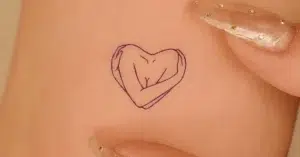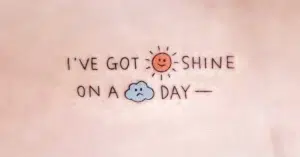In the art of tattooing, where skin is the canvas and ink is the voice, one tattoo artist stands out for his unique blend of tradition and modernity. A former product design student turned tattooist, he has chosen a path less traveled, one that speaks to his adventurous spirit and creative freedom.
In this blog, we meet a craftsman, CC, who found his calling not in the confines of an office but in the vibrant strokes of calligraphy that grace the skin. From his rebellious start to his innovative fusion of surrealism with the timeless elegance of Chinese script, his story is one of artistic exploration and personal expression.
Let’s step into his world, where every tattoo is a narrative, and every design is a testament to his unwavering commitment to his art. If you want to share your tattoo story, please don’t hesitate to contact us.

Interview Content
1. We’d like to know more about your background before you get into the tattoo industry.
CC: I majored in Product Design in college, which is considered part of the arts. But I felt that I wasn’t cut out for the typical jobs in that field, so I started looking for other options.
After graduation, I went to Xiamen and worked part-time for a month in a teahouse on a mountain. The environment there was great; it allowed me to experience a different kind of life while giving me the space to reflect and think about what I really wanted.

2. So, what inspired you to become a tattoo artist? Were you influenced by the people or events around you?
CC: Not really, to be honest. Most of my friends are the 9-to-5 type. In my social circle, I’d say I’m the one who’s a bit more rebellious.
The choice to go into tattooing isn’t something that came with a big ‘aha’ moment or anything. I guess there were some underlying factors. I’ve always been a bit of a free spirit, always up for a good time and full of ideas. Ever since high school, I’ve been into side gigs. So, I had my own little stash of cash, which made life a lot more colorful and free compared to my peers.
After college, the idea of a regular job just didn’t sit right with me. I prefer the freedom to do my own thing. So, becoming a tattoo artist seemed like a great choice.

3. When did you first get involved with tattoos?
CC: My initial exposure to tattoos was through movies and TikTok, where I saw a variety of traditional and unique tattoo styles, like full-body and large-scale back pieces. I’ve got an old-school traditional leg piece myself.
My first tattoo was when I was 18, and it was pretty rough. Gradually, I started visiting tattoo studios, inquiring about tuition fees and the learning process, and chatting with tattoo artists about style. I’d say I officially got into tattoos when I made up my mind to learn, because that’s when I began to systematically understand all the professional knowledge.

Old school tattoo. Credit to @Minha Tatuagem | Pinterest
4. Why did you choose the calligraphy style? What type of tattoos do you do most for your clients now?
CC: I’ve always had a keen interest in calligraphy, and since I didn’t start with any other tattoo styles, I’ve been focusing on this style ever since I entered the industry.
Initially, I was mainly tattooing in the Slender Gold Script style from the era of Emperor Huizong of the Song Dynasty. Later, I wanted to try blending it with other calligraphy styles, so I began constantly seeking out various examples and practicing them. Although the innovation process is quite lengthy, it’s easier to stick with it because it’s something I truly enjoy.
Currently, I do a lot of tattoos that combine running script(Xingshu) and cursive script(Caoshu) for my clients because the Slender Gold Script has its limitations.
Additional Notes: Running Script(Xingshu) is a style of calligraphy that lies between Regular Script (Kaishu) and Cursive Script (Caoshu), characterized by its fluidity and rhythmic grace. Cursive Script, on the other hand, is a more free-flowing and swift style of writing, known for its continuous strokes and significant variations in form.

5. When designing tattoos, how do you balance the calligraphy style with the client’s needs?
CC: I start by creating within the framework of traditional calligraphy, but I also add my own creative elements. If every calligraphy tattoo were designed strictly according to ancient standards, it would lose its unique meaning for the client.
Although sometimes the client’s requirements may not perfectly align with my style, I’m always open to making adjustments. I guide the client based on their preferences and supplement with my professional knowledge to help them better understand what they’re about to do. I aim to respect the client’s wishes while ensuring their satisfaction.
If I encounter a situation where I really can’t meet the client’s needs, such as when the design they want is not something that fits my aesthetic, I would choose to politely decline. I won’t compromise my principles for the sake of making money.

6. In your professional career, are there any works that you’re proud of or any interesting client stories?
CC: Even though I’ve only been doing this for two years, one piece really stands out to me—a tattoo covering a birthmark. The client initially wanted to use a large design to cover the entire birthmark, but I felt that doing so would lose the birthmark’s unique significance. A tattoo is not just a personal work of art; it can also be an expression of one’s own story.
Although he didn’t want to show others his birthmark, I believe that if a tattoo design can make someone confidently display what they were once reluctant to show, then that tattoo design is a success. This is one of the reasons tattoos exist. I’m very pleased that the final cover-up design I created was satisfactory to the client.

7. In the art of tattooing, what unique position do you think calligraphy holds?
CC: Calligraphy is a traditional form of Chinese art, and tattoos in this style can promote China’s traditional culture. Compared to other artistic forms, such as fine-brushwork paintings, traditional Chinese paintings, and ink-wash paintings, I think calligraphy is more accessible to people.
Firstly, calligraphy is a common presence in everyday life, which makes it more relatable and likely to resonate with people. Secondly, some people might prefer simpler designs over complex patterns, making calligraphy an excellent choice for them. Calligraphy tattoos can be presented in a simple format that allows individuals to appreciate the unique charm of Chinese culture.

8. What advice or experience would you share for newcomers who want to get into the tattoo industry?
CC: I’d recommend finding a reputable tattoo studio or institution because, in an apprenticeship system, the mentorship and guidance from a master is crucial. Some disreputable studios might be more interested in collecting tuition fees and could assign under-qualified apprentices to instruct newcomers. So, finding the right shop can make a big difference in terms of sticking with learning and growing in the field.

9. So, how can one determine if a tattoo shop is good?
CC: It’s challenging to judge whether a tattoo shop is good, but I’d suggest attending tattoo conventions to find artists or studios that resonate with you. Alternatively, you could visit the studio in person to get a feel for the atmosphere and the professionalism of the tattoo artists. Besides personal recommendations, you can also search for information on social media platforms to learn as much as you can about the shop’s portfolio and reputation.

10. Are you currently trying out any new tattoo styles? Is there a particular design you’re looking to challenge yourself with?
CC: I’m in a phase of exploration and creation right now. I’m experimenting with combining calligraphy with a stream-of-consciousness approach to develop a new form of tattoo design.
Although it’s a challenging journey, I find this fusion intriguing and worth pursuing. Additionally, I’m looking to innovate and make changes based on traditional calligraphy to create works with a distinctive style.

Hyperskin Tattoo: Thank you so much for sharing your experiences and insights. We wish you continued success on your journey in the art of tattooing!
That concludes our interview. We hope that tattoo artist CC’s fascinating journey has provided valuable information for tattoo enthusiasts. Additionally, we encourage everyone to share their own stories—we’re looking forward to hearing from you. Here’s to your success on the path to chasing your dreams!




